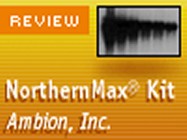
Northern analysis is a standard laboratory procedure for quantitation and detection of mRNA following transfer and immobilization on a membrane. The procedure is straightforward but wrought with inefficiency and inconsistency. The instability of mRNA leads to this procedure being very time-consuming and difficult. Ambion claims the NorthernMax Kit has been optimized to maximize efficiency to provide excellent sensitivity of radiolabeled and nonisotopic probes. My experience with this kit supported this claim by providing a complete package that simplified the procedure and produced a clear northern blot.
This kit comes with all the required RNase-free reagents (stored at room temperature) eliminating the need to bake glassware and make reagents to prevent contamination. The user need only provide DEPC water for dilutions. The gel is prepared by first melting 1g of the kit-provided agarose in DEPC water and then adding 10ml 10X denaturing gel buffer. The electrophoretic equipment must be thoroughly cleaned with the RNA Zap (also provided) before the gel is poured. The electrophoresis chamber is then set up with the gel and 1X MOPS gel running buffer. The RNA sample (up to 30ug) is prepared by mixing it with 3 volumes formaldehyde load dye along with ethidium bromide for pre-visualization before blotting. The RNA is then incubated at 65oC for 15 minutes to denature the secondary structure of the RNA and is subsequently placed on ice.
Following loading, the gel is run at ~5V/cm until the bromophenol blue dye front is almost to the bottom of the gel. The gel can be visualized briefly with a UV light. At this point, the RNA is transferred to a positively charged nylon membrane. Nitrocellulose membranes should not be used. Ambion sells a BrightStar-Plus membrane that has been optimized for use with this kit but any positively charged membrane would be suitable. A downward transfer assembly is set-up with dry paper towels on the bench top and dry to wet chromatography paper on top. The membrane is then placed on the chromatography paper and the gel is set on top. At this point, wet chromatography paper is layered and a bridge is set on top that leads to a tray of transfer buffer. The assembly must be set such that there is no ‘short-circuiting’ between the bridge and the dry paper towels below the membrane. The stack is then covered with a weight. The protocol recommends a 1.5-2 hour transfer. Once the transfer setup is disassembled, UV light or baking at 80oC for 15 min may be used to treat the membrane, crosslinking the RNA. The blot is prehybridized with preheated ULTRAhyb solution for 30 minutes at 42oC for DNA probes and 68 oC for RNA probes in a hybridization bag. Following the initial ULTRAhyb incubation, the probe can be added directly to the same solution (ULTRAhyb solution used in prehybridization) at a concentration dependent on the type of probe (1.0-10pM for nonisotopically labeled DNA probes). The membrane is then hybridized for 2 hours to overnight at the same temperature as used for prehybridization. This kit also comes with the preliminary washing buffers for low stringency and high stringency washing, however from this point on the detection can be done according to the probe used.
I used this kit with a biotinylated DNA probe using low concentrations of RNA from Staphylococcus aureus. I have used standard methods in the past using homemade reagents and dealing with the rigors of washing and baking everything. This kit made the whole process quicker and more efficient since it provided all the reagents and a very detailed manual. After detection, my northern blot was clear with minimal background on the first try. Ambion claims the UltraHyb buffer increases signal by 20-50 fold over traditional hybridization buffer requiring 10-100 fold less DNA probe. This kit provides an easy to use method for the cumbersome and often frustrating Northern blot hybridization.
Katrina Williams
Lab Specialist, Sr
McGuire VAMC
Richmond, VA